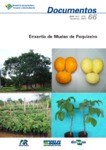Please use this identifier to cite or link to this item:
http://www.infoteca.cnptia.embrapa.br/infoteca/handle/doc/567319| Title: | Enxertia de mudas de pequizeiro. |
| Authors: | PEREIRA, A. V.  PEREIRA, E. B. C.   JUNQUEIRA, N. T. V.   FIALHO, J. de F.   |
| Date Issued: | 2002 |
| Citation: | Planaltina, DF: Embrapa Cerrados, 2002. |
| Pages: | 26 p. |
| Description: | ABSTRACT: The pequi (Caryocar brasiliense Camb.) is a native tree from the Brazilian savannah. Its fruits have special taste and flavor and are used for preparing hot dishes which are much appreciated by the local population. The remaining native plants are not enough to supply the increasing demand for this fruit, leading to interest in its cultivation. Hence, much research is needed, mainly the appropriate sexual and vegetative propagation methods. Like many other fruit trees, the latest method seems to be the prerequisite for the domestication and cultivation of native species. In this way, grafting and budding techniques are very important for fruit tree cloning and breeding. Therefore, the objective of this paper was to present the latest results about the potential and use of grafting and budding on mangaba, and to ofter technical advice to the breeders and the farmers dealing with this specie. Many aspects about rootstocks production, grafting and budding approaches are discussed, including the nursey management practices, such as seed and sowing details, recipients and substrates, manuring, watering, pest and disease control. |
| Thesagro: | Caryocar Brasiliense Cerrado Enxerto Garfagem Muda Pequi Propagação Vegetativa Reprodução Vegetal Reprodução Assexuada |
| NAL Thesaurus: | asexual reproduction plant propagation rootstocks |
| Keywords: | Fruta nativa Grafting Indigenous organisms Cuttings |
| Series/Report no.: | (Embrapa Cerrados. Documentos, 66). |
| Type of Material: | Folhetos |
| Access: | openAccess |
| Appears in Collections: | Série Documentos (CPAC)  |










